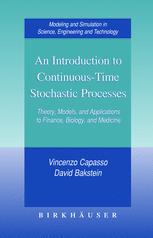

Most ebook files are in PDF format, so you can easily read them using various software such as Foxit Reader or directly on the Google Chrome browser.
Some ebook files are released by publishers in other formats such as .awz, .mobi, .epub, .fb2, etc. You may need to install specific software to read these formats on mobile/PC, such as Calibre.
Please read the tutorial at this link: https://ebookbell.com/faq
We offer FREE conversion to the popular formats you request; however, this may take some time. Therefore, right after payment, please email us, and we will try to provide the service as quickly as possible.
For some exceptional file formats or broken links (if any), please refrain from opening any disputes. Instead, email us first, and we will try to assist within a maximum of 6 hours.
EbookBell Team

5.0
20 reviewsThis concisely written book is a rigorous and self-contained introduction to the theory of continuous-time stochastic processes. A balance of theory and applications, the work features concrete examples of modeling real-world problems from biology, medicine, industrial applications, finance, and insurance using stochastic methods. No previous knowledge of stochastic processes is required.
Key topics covered include:
* Interacting particles and agent-based models: from polymers to ants
* Population dynamics: from birth and death processes to epidemics
* Financial market models: the non-arbitrage principle
* Contingent claim valuation models: the risk-neutral valuation theory
* Risk analysis in insurance
An Introduction to Continuous-Time Stochastic Processes will be of interest to a broad audience of students, pure and applied mathematicians, and researchers or practitioners in mathematical finance, biomathematics, biotechnology, and engineering. Suitable as a textbook for graduate or advanced undergraduate courses, the work may also be used for self-study or as a reference. Prerequisites include knowledge of calculus and some analysis; exposure to probability would be helpful but not required since the necessary fundamentals of measure and integration are provided.